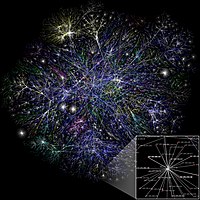
Photo from wikipedia
Abstract Animal-attached accelerometers have been widely used to monitor species that are difficult to observe, alongside the use of machine learning to identify behaviours from the obtained sequences. Artificial neural… Click to show full abstract
Abstract Animal-attached accelerometers have been widely used to monitor species that are difficult to observe, alongside the use of machine learning to identify behaviours from the obtained sequences. Artificial neural networks are powerful supervised learning algorithms that are based on deep learning and have been poorly exploited in movement ecology. Recently, the availability of sophisticated algorithmic architectures via open source libraries facilitates their use. In this study, we adapt a fully convolutional neural network that was originally developed for biomedical 3D image segmentation: the V-net. We test it on a labelled dataset collected from animal-borne video recorders combined with multi-sensors (accelerometers, gyroscopes and depth recorders) deployed on free-ranging immature green turtles (Chelonia mydas). The proposed model, fitted for 1D data, is able to predict six behavioural categories for green turtles with an AUC score of 88%. It shows a high ability to detect rare behaviours with low discriminative signals such as Feeding and Scratching. With a precision down to one centisecond, the V-net circumvents the segmentation process. We also show that the gyroscope is more informative than the accelerometer in identifying sea turtle behaviours and that the V-net is not able to discriminate Feeding from the raw data of accelerometer alone. However, human expertise can help to correct it with precise and adapted pre-processing. Thus, diverted from its initial purpose and tested on sea turtle, the V-net is a very efficient method of behavioural identification that should be easily generalized to a wide range of species. It could lead to considerable progress in remote accelerometric monitoring and help to understand the ecology of the species that are difficult to observe. Furthermore, as the model is light, there is also a huge potential to implement a trained V-net in satellite-relay data tag to remotely predict the expressed behaviours almost instantly.
Journal Title: Ecological Modelling
Year Published: 2021
Link to full text (if available)
Share on Social Media: Sign Up to like & get
recommendations!